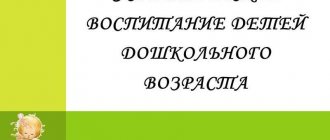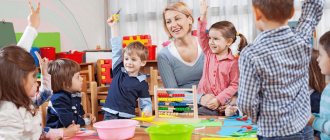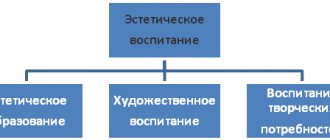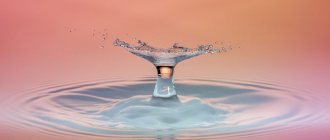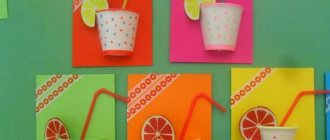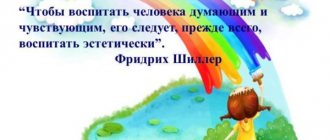Artistic and aesthetic development and artistic and aesthetic education of preschool children
Ekaterina Chernysheva
Artistic and aesthetic development and artistic and aesthetic education of preschool children
«Artistic and aesthetic development»
and “
Artistic and aesthetic education .
Before talking about the concept of “ artistic and aesthetic development ”
Let us consider the concepts of
“aesthetic
education ” and
“
artistic education ” .
Aesthetic education of preschoolers is a long process, the goal of which is to develop in children the ability to perceive the beauty of the world around them, as well as the development of creative abilities that are in their infancy. It starts almost from birth. Aesthetic education of young children , essentially preschool , is a fairly broad concept. It includes the development of attitudes towards the world , everyday life, nature, work and social life in general.
Artistic education is identified as its component .
Artistic education involves education through the means of art. According to classical studies, its main goal is the formation of a culture of creative personality, which manifests itself socially and individually and which, in the process of identifying the internal image and in the creative perception of the external world, creates artistic values . Its main task is to form a child’s positive and active attitude towards art and the need for it.
The concept of "aesthetic education "
much broader, it affects both
artistic creativity and the aesthetics of everyday life, behavior, work, and relationships. Aesthetic education shapes a person with all aesthetically significant objects and phenomena, including art as its most powerful means. Aesthetic education artistic education for its purposes , develops a person mainly not for art, but for his active aesthetic life.
There are different definitions of the concept of “ artistic and aesthetic education ”. Let's look at some of them.
From the dictionary of aesthetics: artistic and aesthetic education is a system of activities aimed at developing and improving a person’s ability to perceive , correctly understand, appreciate and create the beautiful and sublime in art.
N. Varkki gives the following formulation: artistic and aesthetic education of preschool children is “a purposeful process of forming a creatively active personality of a child, capable of perceiving and appreciating the beauty in life and art.”
Zaporozhets I.D. defines artistic and aesthetic education as “the organization of children’s life and activities, promoting the development of the child’s aesthetic and artistic feelings , the formation of ideas and knowledge about the beauty in life and art, aesthetic assessments and an aesthetic attitude towards everything that surrounds us.”
In both definitions, we are talking about the fact that artistic and aesthetic education should form artistic taste , develop and improve in the child the ability of aesthetic awareness of beauty in art and in life, to correctly understand and evaluate it.
According to D. B. Likhachev, artistic and aesthetic education is a purposeful process of formation of a creative personality capable of perceiving , feeling, appreciating beauty and creating artistic values .
T. N. Fokina believes: “ Artistic and aesthetic education is the education of a holistic, harmoniously developed personality , which is characterized by a well-formed aesthetic consciousness, the presence of a system of aesthetic needs and interests, creative abilities, a correct understanding of beauty in reality and art.”
From these definitions it is clear that artistic and aesthetic education develops the ability for independent creativity and the creation of beauty, develops the ability to creatively create handmade products.
So, artistic and aesthetic education has an active and creative orientation, which should not be limited only to a contemplative task, it should also form the ability to create beauty in art and life.
These goals are also reflected by the peculiarity of artistic and aesthetic education as part of the entire pedagogical process. Any goal cannot be considered without tasks. Most teachers (G. S. Labkovskaya, D. B. Likhachev, E. M. Toroshilova and others)
There are three leading tasks
of artistic and aesthetic education :
- the creation of a certain stock of elementary aesthetic knowledge and impressions, without which inclination, craving, and interest in aesthetically significant objects and phenomena cannot arise.
— “the formation, on the basis of acquired knowledge, and the development of the abilities of artistic and aesthetic perception of such socio-psychological qualities of a person that provide her with the opportunity to emotionally experience and evaluate aesthetically significant objects and phenomena, to enjoy them” (V. G. Razhnikov)
.
artistic and aesthetic creative ability in each The essence of this task is that the child must not only know beauty, be able to admire and appreciate it, but he must also actively participate in the creation of beauty in art and life, and independently create handmade products. The result of artistic and aesthetic education is artistic and aesthetic development as “the process and result of mastering the aesthetic and artistic experience of mankind , the development of the ability to experience various phenomena of reality as beautiful, to respond emotionally to artistic images and the manifestation of beauty in the world; formation and improvement of aesthetic consciousness, attitude to human aesthetic activity" (A. G. Gogoberidze, O. V. Solntseva)
.
It is important to develop such qualities , such abilities that will allow the individual not only to achieve success in any activity, but also to be the creator of aesthetic values, to enjoy them and the beauty of the surrounding reality. In addition to the formation of artistic and aesthetic attitude to reality and art, artistic and aesthetic education simultaneously contributes to their comprehensive development . It contributes to the formation of a person’s morality, expands his knowledge about the world, society and nature. A variety of creative activities for children contribute to the development of their thinking and imagination, will, perseverance, organization, and discipline.
The entire system of artistic and aesthetic education is aimed at the overall development of the child, both in aesthetic and artistic terms , and in spiritual, moral and intellectual terms. This is achieved by solving the following tasks: mastering the child’s knowledge of artistic and aesthetic culture , developing the ability for artistic and aesthetic creativity and development of aesthetic psychological qualities of a person, which are expressed by aesthetic perception , feeling, evaluation, taste and other mental categories of aesthetic education .
The concept of “ artistic and aesthetic development ”
is broader than the concept of
“
artistic and aesthetic education ” , since in
the artistic and aesthetic development of the individual the main role is given to artistic and aesthetic education - as a purposeful, systematic activity to manage the process of formation of the personality as a whole or its individual qualities. But, as we know, development also depends on interaction with the environment and on biological factors. While artistic and aesthetic education depends on the spiritual and moral values that are accepted in the family, society, and state, that is, it depends on the environment in which a person is brought up .
How (with what)
artistic and aesthetic development carried out educational organization?
In accordance with the Federal State for preschool education, artistic and aesthetic development assumes :
— development of prerequisites for value-semantic perception and understanding of works of art (verbal, musical, visual, the natural world;
- the formation of an aesthetic attitude towards the surrounding world;
— formation of elementary ideas about types of art;
- perception of music , fiction , folklore;
- stimulating empathy for the characters of works of art ;
- implementation of independent creative activities of children (visual, constructive-model, musical, etc.)
.
Artistic and aesthetic development by communication with beauty in all its manifestations. First of all, it should be highlighted:
— communication with beauty in nature;
- communication with art (music, literature, theater, works of artistic and decorative creativity );
- communication with beauty in everyday life, including human relationships.
Aesthetic communication is a special condition and means of aesthetic education , aimed at getting children interested, igniting their hearts, developing activity in them , awakening in every child faith in his creative abilities, in the fact that he came into the world to create goodness and beauty, bring people joy.
Educational work on the artistic and aesthetic development of children in preschool educational institutions should be carried out simultaneously in several directions:
— interaction between teachers and children.
- interaction with families.
— cooperation with institutions of the social and pedagogical environment.
One of the most important components of the system of work on the artistic and aesthetic development of children is the organization of the educational process. In kindergarten, interaction between teachers and children on artistic and aesthetic development is carried out through the following forms of work:
- direct educational activities (classes in basic activities: drawing, modeling, appliqué, music, reading fiction ). Modern forms of organizing classes are diverse and are designed based on an understanding of the essence and originality of artistic , musical, and verbal works of art. It is also necessary to organize work with an artistic and aesthetic orientation in all types of classes (integration of educational areas)
.
This is the inclusion of artistic expression , musical accompaniment, demonstration of illustrations, dramatization, etc. Educational situations can be organized during a walk (drawing “in the open air”
, etc.)
- joint activities of teachers and children (holidays, entertainment , themed musical evenings, theatrical performances, didactic games, exhibitions of drawings and crafts, etc.). The modern form is projects of an artistic and aesthetic orientation . You can take as a basis the topics proposed by the children, as well as those provided for in the educational program. One of the interesting forms of organizing children's activities is an excursion (to parks, gardens, museums, theaters, around the city, to the library, etc.)
.
At the same time, we must remember that the main object of cognition should remain the emotional and figurative contemplation of what is perceived (genuine objects in their pristine state, harmony and connection with the surrounding space).
- independent children's activities (games and exercises that stimulate the expansion of aesthetic experience, its processing and reflection; design activities aimed at changing the group space and “play corners”
, compiling various collections, staging, productive activities, activities based on interests, etc.).
Work with children on artistic and aesthetic development is carried out in the following areas:
-introduction to the fine arts and the development of creativity in visual activity (activation and development of an emotional response to the manifestation of beauty in the surrounding world, its depiction in works of art and one’s own creative works, the development of artistic and aesthetic perception , aesthetic assessments, preferences, desire to experience art; development emotional-aesthetic, creative, sensory and cognitive abilities, development of visual activity, activation of creative manifestations of children in the process of familiarization with art and their own visual activity).
-musical education ( development of general musical culture, accumulation of experience in interaction with musical works, development in the child of the position of an active participant, performer-creator of musical works, in order to express himself, his emotions, feelings, moods, experiences in singing, dancing, playing music).
-literary development (as a process of qualitative changes in perception , interpretation of literary texts and the ability to reflect literary experience in different types of artistic activity ).
It is important to remember that in artistic activity (both organized and independent)
There must be both
a reproducing (reproductive)
factor and a creative one.
Both of them are necessary and interconnected, because a child will not learn to create without learning to reproduce .
The content of the artistic and aesthetic development of children is presented in the sections of comprehensive programs, partial programs and technologies. Modern programs are focused on the ideas of an integrative approach: combining different types of arts (music, speech, theater, fine arts)
into
an artistic whole .
However, no educational influence of an adult can be successfully implemented without the real activity of the child himself. At the same time, it is important to remember that activity in an enriched subject-development environment , which should initiate the child’s activity and direct him to creativity.
What it is?
In pedagogy, the artistic and aesthetic development of a preschooler is understood as the formation of the ability to perceive the beauty of the surrounding world, as well as the development of the ability to show creative activity.
These qualities are developed in a child already in preschool age.
Artistic and aesthetic development performs the following tasks:
- Develops the emotional sphere of the child’s inner world.
- Helps accumulate aesthetic knowledge and standards.
- Forms the ability to enjoy aesthetic objects, as well as express one’s own attitude towards them.
- Develops abilities in the creative field.
These goals are achieved through various forms and types of aesthetic development.
Conversations are held with preschoolers on topics about the sublime and beautiful.
Communication with nature, which is an inexhaustible source of beauty, plays a big role.
In addition, it is important how the space in which children are is organized; it also has educational significance.
Preschoolers directly participate in a variety of creative activities - drawing, dancing, music, crafts, etc. In holidays and games, children embody artistic ideas that they became acquainted with during the learning process.
There are various forms of organizing artistic and aesthetic development:
- Games.
- Training sessions.
- Exhibitions.
- Excursions.
- Holidays.
IMPORTANT! It is necessary to select the form and type of activity in the artistic and aesthetic sphere in accordance with the age and interests of the students. The goals that the teacher strives for should be taken into account.
Activities to develop abilities in preschool age
There is a huge variety of creative activities that contribute to the development of artistic perception of preschoolers, who vary in age and type of creativity.
Classes for 3-4 years
REFERENCE! At this age, babies are just learning to express a positive reaction when they see familiar objects. They are not yet ready to perceive an artistic image, but choose certain pictures simply because they like them or resemble familiar objects.
One of the effective ways to develop artistic and aesthetic skills in children of primary preschool age is unconventional drawing. This provides an incentive to develop the ability to think outside the box and experiment. The arsenal of unconventional drawing is very diverse:
- Drawing with stencils - in this case, paint is applied to a pre-prepared stencil using a variety of tools: a sponge, a brush, a roller or even ordinary rags.
- Drawing with stamps, palms, leaves, cotton swabs, etc. - in this case, paint is applied to a stamp or something that replaces it and an impression is made on paper. Prints can be formed into patterns, and you can experiment with color.
- Drawing on wet paper differs from regular drawing in that paint is applied to a pre-moistened sheet and it spreads, creating unexpected patterns. At the same time, the child learns to follow what happens and guide the drawing process.
Modeling from plasticine not only forms artistic and aesthetic perception, but also promotes the development of fine motor skills, which is very important in preschool age. To deepen the effect of these activities, plasticine figures sculpted by children are used to dramatize fairy tales.
IMPORTANT! Musical classes can be either an independent form of creativity or accompany the creative process in other directions. For example, when a teacher turns on music while drawing or sings songs with children while dramatizing fairy tales.
Classes for 5-7 years old
REFERENCE: At the age of 5, a child is already able to receive aesthetic pleasure from contemplating a painting, but for him the color scheme is more important than the composition. At the age of 6-7 years, perception becomes much more subtle, children capture the inner mood of the image.
At this age, the possibilities for creative activities with children expand, as the children’s abilities also expand.
Older preschoolers have more complex skills and can complete more complex tasks.
For example, children 6-7 years old can engage in floristry, quilling, papermaking, etc.
Floristry is the creation of compositions from plant materials. It requires the child to be able to see the image, select the necessary shapes and shades of colors, and carefully work with fragile material.
For work, you can use leaves, flowers, twigs, moss and other plant materials.
Quilling is the making of pictures from rolled strips of paper. This is a rather painstaking task that requires patience and perseverance. Artistically, children learn to compose a composition and select colors.
Papermaking is an excellent tool for developing imaginative thinking. By making three-dimensional models from paper, preschoolers solve design problems, show imagination and aesthetic taste. Additionally, paper craft activities can be complemented by storytelling, drama, and other forms of creative development.
IMPORTANT! In older preschool age, children begin to get acquainted with the masterpieces of world artistic culture - paintings, architecture, literature (fairy tales, poems), etc. This happens in the form of conversations, viewing photographs, and reading.
